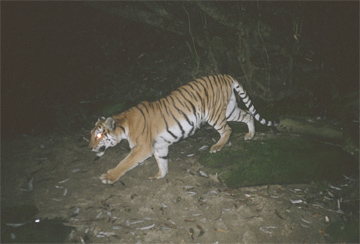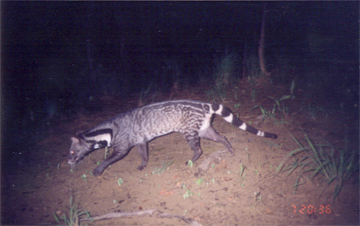Camera traps provide glimpses of predators in Myanmar
Camera traps capture photos of predators in Myanmar
WCS
September 4, 2008
Myanmar's dense northern wild lands, researchers from the Wildlife Conservation Society have painstakingly gathered a bank of valuable data on the country's populations of tigers and other smaller, lesser known carnivores (see photo attachments). These findings will help in the formulation of conservation strategies for the country's wildlife.
Using camera traps survey techniques, researchers from WCS’s Myanmar Program have combed the 3,250-square-kilometer core area (approx. 1,250 square miles) of the Hukaung Tiger Reserve, the world’ largest protected area for tigers, for evidence of the big cats and other wildlife. The recently published data were gathered between December 2002 and May 2004.
During that time, the researchers photographed six individual tigers some 21 times in the reserve, and this has allowed the first ever scientific estimate of abundance for these big cats in northern Myanmar.

|
“We know there are tigers here, but previously we were not able to put some numbers to the population,” said Wildlife Conservation Society researcher, U. Than Myint, co-author for an article in the July edition of the journal Population Ecology which details efforts to measure tiger numbers in Myanmar’s Hukaung Tiger Reserve. “We have collected the first real data needed to determine how many tigers are here. From the analyses of this data, it is estimated that there are at least seven and potentially up to 70 tigers living in the core area. Estimating numbers of prey animals such as gaur and sambar may give an indication of how many tigers can be supported over this vast habitat, but any further ecological monitoring will likely need to be done at the same time as efforts are increased to protect tigers and their key prey species from illegal hunting and trade.”
Researchers have also confirmed the continued existence of 18 smaller carnivores in a variety of habitats across Myanmar, according to another study by WCS’s Myanmar Program that appeared in the April edition of the journal Small Carnivore Conservation. Data on small carnivores gathered from camera-trap surveys in wild areas across the country were supplemented by the examination of animal remains found in villages and markets. The researchers found that some species such as the yellow-throated marten and the common palm civet are common throughout their country range. Red pandas were not photographed but identified as present in Hkakaborazi National Park and other areas. Other species that were not detected at all in the surveys, such as four species of otter, could be in need of protection.
“One of the most important needs for the conservation of these wild places is to get a better understanding of the status of these predators,” said WCS researcher U. Than Zaw, lead author of the small carnivore study. “So far, we’ve determined that otter populations have been decimated, mostly through a combination of hunting for their pelts and for medicines, and through loss and disturbance of their aquatic habitats. Otters require immediate conservation management. As for the other species, continued monitoring is needed to better ascertain the ecological needs of Myanmar’s wildlife.”
Funding for the research efforts were provided by the U.S. Fish and Wildlife Service’s Rhino and Tiger Conservation Fund, the National Fish and Wildlife Foundation’s Save the Tiger Fund, and the Liz Claiborne Art Ortenberg Foundation.








